
A trolleybus is an electric bus that draws power from dual overhead wires using spring-loaded trolley poles. Two wires, and two trolley poles, are required to complete the electrical circuit. This differs from a tram or streetcar, which normally uses the track as the return path, needing only one wire and one pole. They are also distinct from other kinds of electric buses, which usually rely on batteries. Power is most commonly supplied as 600-volt direct current, but there are exceptions.
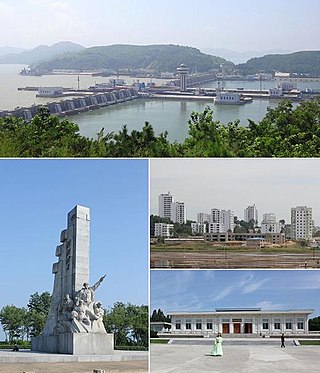
Nampo, also spelled Namp'o, is a city in North Korea which is the country's fourth-largest by population. The city is an important seaport in the country as it lies on the northern shore of the Taedong River, 15 km east of the river's mouth. Formerly known as Chinnamp'o, it was a provincial-level "Directly Governed City" ("Chikhalsi") from 1980 to 2004, and was designated a "Special City" in 2010. Nampo is approximately 50 km southwest of Pyongyang, at the mouth of the Taedong River. Since North Korean independence, the city has developed a wide range of industry and has seen significant recent redevelopment.

Chŏngjin is the capital of North Korea's North Hamgyong Province (함경북도) and the country's third-largest city. It is sometimes called The City of Iron.

The Pyongyang Metro is the rapid transit system in Pyongyang, the capital and largest city of North Korea. It consists of two lines: the Chollima Line, which runs north from Puhŭng Station on the banks of the Taedong River to Pulgŭnbyŏl Station, and the Hyŏksin Line, which runs from Kwangbok Station in the southwest to Ragwŏn Station in the northeast. The two lines intersect at Chŏnu Station.

Pyongsong is a city in North Korea, the capital city of South Pyongan province in western North Korea. The city is located about 32 kilometres northeast of Pyongyang, and was formally established in December 1969. It has a population of 284,386.

Pyongyang Tram is a public tram system in Pyongyang, the capital of the North Korea. The first line of the current system opened in 1989. There are currently four lines in operation.

P'yŏngch'ŏn-guyŏk is one of the 18 guyŏk of P'yŏngyang, North Korea. It is bordered by the Taedong River in the south and the Pothonggang Canal in the north and Potong River in the west, and to the east by Chung-guyŏk, from which it is separated by the yard area of P'yŏngyang railway station.
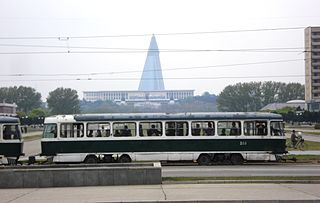
Trams and trolleybuses in North Korea are forms of public transportation for North Koreans to travel around in urban centres given the shortages on fuel and access to cars for average citizens.

Tatra KT4 is the name of a four-axle type articulated tramcar developed by the Czech firm ČKD Tatra. The first pre-production vehicles entered service in Potsdam in 1975, with the first production vehicles in 1977. A total of 1,747 units were built, with initial deliveries to East Germany (DDR) and later to the USSR and SFR Yugoslavia. KT4 variants were built for both standard gauge and metre gauge tramways. Production of the KT4 tramcar was halted in 1991 due to worldwide economic and political changes at the time. Production was briefly resumed in 1997 to construct the last 20 units for Belgrade, Serbia.
The automotive industry in North Korea is a branch of the national economy, with much lower production than the automotive industry in South Korea. In North Korea motor vehicle production is focused on military and industrial goals, including construction; few private citizens own cars.
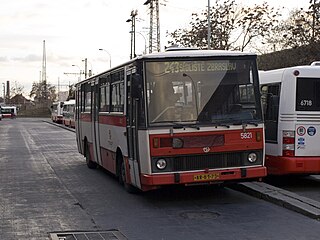
Karosa B 732 is an urban bus produced from 1983 to 1997 by bus manufacturer Karosa from the Czech Republic. It was succeeded by Karosa B 932 in 1997.
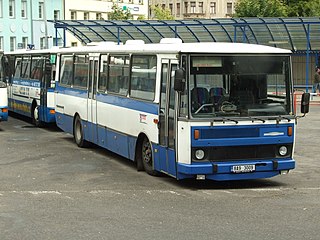
Karosa C 734 is an intercity bus produced from 1981 to 1996 by bus manufacturer Karosa from the Czech Republic. It was succeeded by Karosa C 934 in 1996.

The Chŏllima Line is a rapid transit line owned and operated by Pyongyang Metro in Pyongyang, North Korea. The line has a depot at Sopo, near the Korean State Railway's Sopo station.
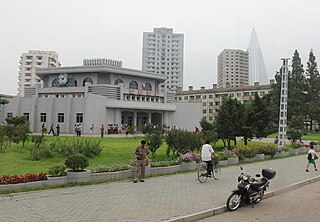
Hwanggumbol Station is a station on Hyŏksin Line of the Pyongyang Metro.

The Juche-class is a 4-part electric multiple unit built by the Kim Chong-t'ae Electric Locomotive Works in 1978, intended for service on the Korean State Railway.

Chongnyon Jonwi is a daily newspaper in North Korea. It is the official organ of the Central Committee of the Socialist Patriotic Youth League. It is one of the three most important newspapers in the country, the other two being Rodong Sinmun and Joson Inmingun. Chongnyon Jonwi is particularly known for jointly publishing New Year editorials with the two papers under the rule of Kim Jong-il. Most of its regular articles are commentary on the contents of Rodong Sinmun from a youth perspective. The editor-in-chief is Choe Sun-chol.

The Chollima-091 (Korean: 천리마-091) is a high-floor, articulated trolleybus built from 2009 to 2018 by Pyongyang Trolleybus Factory for the Pyongyang trolleybus system. The name refers to the Chollima Movement which in itself derives from the mythological Chollima while the model number means year of development 2009, model 1. Since the 1960s, most of the trolleybuses in Pyongyang were named after this mythological creature. It was first produced as a prototype in 2009 and entered mass production in 2010. It is the most common vehicle in Pyongyang's trolleybus network and the vehicle with the most number in service in the DPRK.
The Chollima-321 (Korean: 천리마-321) is a North Korean trolleybus with battery power built by the Pyongyang Trolley Bus Factory. The name 'Chollima' refers to a myth about a winged horse that has since been adopted as the name of North Korea's Stakhanovite movement. The production of the Chollima-321 production replaced the Chollima-091 articulated trolleybus, due to the need to replace older Chollima-961, -951, Ikarus and Karosa bus based trolleybuses. The trolleybus features on a 50 won stamp.
The Pyongyang Trolleybus Factory (PTBF) is an automotive industry company in North Korea and is the largest trolleybus manufacturer in the DPRK. During its existence, it has also manufactured vans, refrigerated trucks and buses although its main product are the Chollima branded trolleybuses. It has continuously manufactured trolleybuses since 1960, when it built the first trolleybus in the DPRK, a Jinghua BK561 clone.























